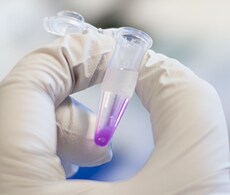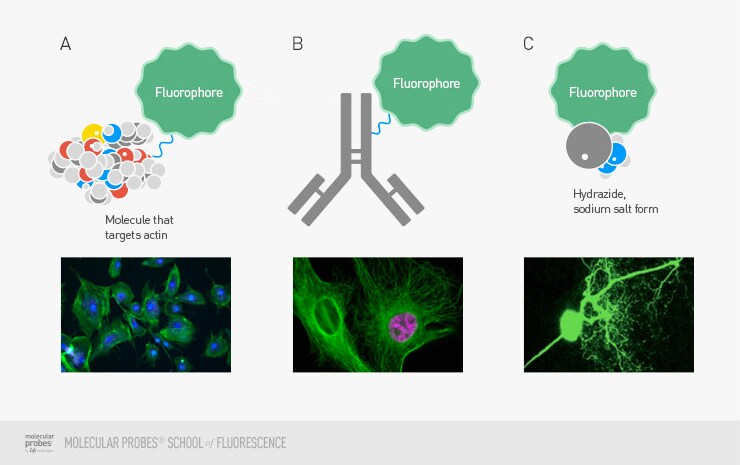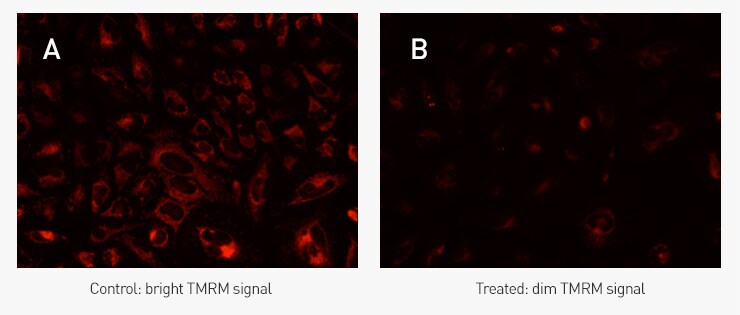Search
荧光标记的不同方法

See cell structures and proteins more clearly
Viewing cells with white light only allows you to see so much. By selectively labeling proteins, structures, and biological processes with fluorescent proteins, dyes or conjugated antibodies, what you can observe and track increases dramatically.
Learn about what characteristics of fluorescent dyes are important and see how they can be used in functional and structural cell analysis studies.
 | 更清楚地观察细胞结构和蛋白使用白光观察细胞,可观察到的信息毕竟有限。通过荧光蛋白、染料或者偶联抗体选择性地标记蛋白、细胞结构和生物过程,可观察和追踪的信息显著增加。 您可在本节了解一些重要的荧光染料特性,及它们如何用于细胞功能和结构分析研究。 |
使用荧光来检测靶标
相比单独使用明场显微镜观察样品,使用荧光显微镜可以提供更好的对比度。使用不同的荧光颜色标记各种不同靶标,您可以同一实验、同一个细胞中观察到不同的蛋白和结构。荧光标记靶标的方法包括荧光染料、免疫标记, 和 荧光融合蛋白法—所有这些方法都可以选择性的标记细胞结构和细胞内蛋白,让您能更轻松地观察到它们的成像图像。
有些染料可用于活细胞, 而有些染料则适用于 固定和透化细胞. 与任何技术一样,用荧光染料标记靶标目标也有一定的局限性。当荧光染料用于标记活细胞时,它们可能是具有 光毒性的. 有时可能无法找到可准确标记出您希望观察到的靶标的荧光染料。如果没有可用的荧光染料,您可以尝试对固定细胞进行免疫标记 或者对固定或活细胞内的 荧光融合蛋白 进行检测。
One fluorescent dye molecule, many different selectivities
Many fluorescent tools for cell biology are essentially fluorophores that have been modified in different ways or conjugated to various molecules to give them a certain function or allow them to bind to specific organelles or proteins.
Through chemical modifications, a single fluorophore can be produced in a number of variant forms, each with a different specificity. For example, the green-fluorescent Alexa Fluor® 488 dye molecule can be modified to target immunolabeling (B), or can act as a whole cell stain (C).

Figure 1. A single fluorophore can be modified to carry out any number of labeling jobs, including functionalized forms for labeling cell structure components such as actin (A) and tubulin (B) and salt forms for whole-cell staining (C).
一种荧光染料分子,多种选择位点
细胞生物学中使用的许多荧光工具,在本质上是通过各种方式修饰或以不同的方式偶联各种分子的荧光团,目的是赋予他们某种功能或使它们连接到特定细胞器或蛋白上。
通过化学修饰后,一种荧光团可以产生若干不同的变体,每种变体具有不同的特异性。例如,绿色荧光Alexa Fluor 488染料分子可以修饰靶标 肌动蛋白微丝 (A), 可连接到IgG上进行免疫标记 (B), 也可对整个细胞染色(C).
 图 1. 一个荧光团可以修饰后起多种标记作用,包括:以各种功能状态标记细胞结构元件,如肌动蛋白(A)、微管蛋白(B);以盐形态进行全细胞染色(C)。
图 1. 一个荧光团可以修饰后起多种标记作用,包括:以各种功能状态标记细胞结构元件,如肌动蛋白(A)、微管蛋白(B);以盐形态进行全细胞染色(C)。
荧光标记方法差异
正如上文所述,荧光标记物通常包括一个为获得特异性而进行过修饰的荧光基团。除了链接荧光基团与各种分子,其他类型的修饰也可以赋予荧光基团新的特性。
将荧光基团链接到某个特定的分子(例如抗体)上,可以赋予荧光基团对靶标(本例中为抗原)的选择性。这种方法的优势是荧光基团连接到靶标,在洗掉任何未连接或多余的荧光染料后,即可获得比背景 信号更强的信号和更好的对比度。
荧光染料最初发光比较暗淡,但外部条件或细胞内部活动会引发他们的亮度增加。例如:
- 连接到靶标后荧光强度增加—许多 细胞核染色剂 (比如SYTOX Green和Hoechst)本身发出的荧光都很弱,但在连接到核酸后,其荧光强度会大大增加,出现非常明亮的信号。
- 细胞内修饰也会增加荧光强度—包含化学活性基团的其他染色剂通过细胞活动受到修饰,以含有酯基的钙黄绿素AM为例,在活细胞内,在活性酯酶存在的条件下,酯基裂解,将无荧光的钙黄绿素转变为发绿色荧光的钙黄绿素。
荧光染料通常具有很高的信噪比,这是因为经过连接或活化的染料荧光强度激增,而游离/未剪切的染料只有微弱的信号。由于未修饰的荧光染料不是很明亮,所以通常不需要洗涤。
Using fluorescent dyes as functional indicators
Sometimes you don’t just want to label something; you want to know if your cells are healthy, or if they are functioning the way they should be. You may want to know: are my cells alive? are they apoptotic? or are they stressed out? There are many fluorescent dyes available that can act as indicators for various cellular functions and answer these questions.
For example, the fluorescent dye tetramethylrhodamine, methyl ester (TMRM) specifically labels mitochondria, and it can also indicate if the mitochondria are healthy. Active mitochondria in healthy cells will maintain a mitochondrial membrane potential, and TMRM is brightly fluorescent in these mitochondria. As mitochondrial membrane potential is lost (in sick or dying cells), TMRM signal is diminished.

Figure 2. Panel A shows TMRM staining in healthy HeLa cells; panel B shows the loss of TMRM signal concurrent with treatment to destroy the mitochondrial membrane potential.
使用荧光染料作为功能性指示剂
有时您可能不只是想标记某些对象;您想知道细胞是否健康,是否具有其应有的功能,您可能还想知道:细胞存活着吗?是否出现了凋亡?或者他们去应激化了吗?许多荧光染料都可作为对各种细胞功能的指示剂,逐一解答上述问题。
例如,荧光染料四甲基罗丹明甲酯(TMRM)专门 标记线粒体, 它也可用来指示线粒体是否健康:健康细胞中的活性线粒体将维持线粒体膜电位,在这些线粒体中TMRM发出明亮的荧光;如果线粒体膜电位破坏(细胞生病或死亡),TMRM信号将减弱。

图 2. 图A显示健康HeLa细胞中的TMRM染色;图B显示线粒体膜电位破坏后TMRM信号丢失。
荧光染料的重要特性
在人们谈论荧光基团或荧光染料时,您可能常会听到消光系数和量子产率等字眼。这些术语是荧光染料分子的物理性质,使化学家能够了解染料的亮度概念。然而,在生物学研究中,荧光染料具有比消光系数和量子产率更多的特性。对于那些需要在某个生物系统中实际使用这些荧光标志物的科研人员,在成像实验的设计中还应考虑许多其他特性。
- 选择性—荧光标志物应该专门靶向您感兴趣的分子或反应。举例来说,如果您想标记肌动蛋白,则需要只靶向肌动蛋白的荧光标记物。
- 信噪比—您需要明亮的荧光信号和较低的非特异性荧光背景信号。高荧光信号与低背景信号的组合会使您关注的靶标和其他背景存在最大的对比度。参见 背景荧光.
- 光稳定性—光稳定性作为一种指标,表明了重复暴露在照射光线的荧光信号的稳定性。不具有光稳定性的荧光染料很难使用,因为可能在您使用显微镜聚焦过程中就已经失去荧光信号。如果您想进行延时成像,光稳定性也很重要。
- 激发/发射特性—您应选择激发和发射特性与所使用的滤光片组相匹配的荧光染料。 参见用合适的滤光片检测荧光信号.
- 环境稳定性—环境不稳定的染料很难使用,虽然有时不可避免要遭遇这种情况。一些荧光染料对空气、光或温度敏感,在开始试验前就必须要考虑这些因素。
仅供科研使用,不可用于诊断目的。